LINCOLN MKZ 2013 Workshop Manual
Manufacturer: LINCOLN, Model Year: 2013, Model line: MKZ, Model: LINCOLN MKZ 2013Pages: 474, PDF Size: 3.79 MB
Page 51 of 474
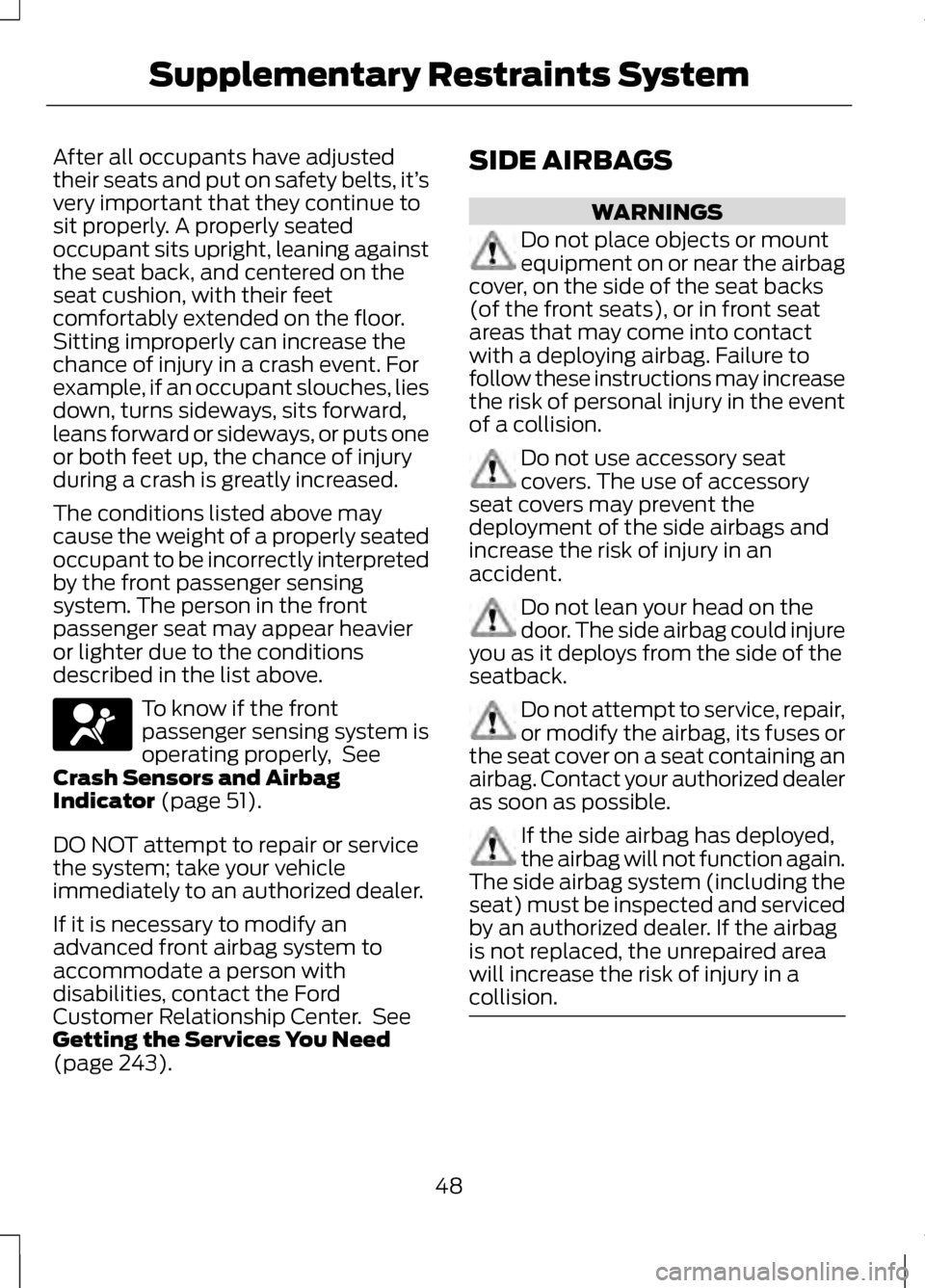
After all occupants have adjusted
their seats and put on safety belts, it’
s
very important that they continue to
sit properly. A properly seated
occupant sits upright, leaning against
the seat back, and centered on the
seat cushion, with their feet
comfortably extended on the floor.
Sitting improperly can increase the
chance of injury in a crash event. For
example, if an occupant slouches, lies
down, turns sideways, sits forward,
leans forward or sideways, or puts one
or both feet up, the chance of injury
during a crash is greatly increased.
The conditions listed above may
cause the weight of a properly seated
occupant to be incorrectly interpreted
by the front passenger sensing
system. The person in the front
passenger seat may appear heavier
or lighter due to the conditions
described in the list above. To know if the front
passenger sensing system is
operating properly, See
Crash Sensors and Airbag
Indicator (page 51).
DO NOT attempt to repair or service
the system; take your vehicle
immediately to an authorized dealer.
If it is necessary to modify an
advanced front airbag system to
accommodate a person with
disabilities, contact the Ford
Customer Relationship Center. See
Getting the Services You Need
(page
243). SIDE AIRBAGS WARNINGS
Do not place objects or mount
equipment on or near the airbag
cover, on the side of the seat backs
(of the front seats), or in front seat
areas that may come into contact
with a deploying airbag. Failure to
follow these instructions may increase
the risk of personal injury in the event
of a collision. Do not use accessory seat
covers. The use of accessory
seat covers may prevent the
deployment of the side airbags and
increase the risk of injury in an
accident. Do not lean your head on the
door. The side airbag could injure
you as it deploys from the side of the
seatback. Do not attempt to service, repair,
or modify the airbag, its fuses or
the seat cover on a seat containing an
airbag. Contact your authorized dealer
as soon as possible. If the side airbag has deployed,
the airbag will not function again.
The side airbag system (including the
seat) must be inspected and serviced
by an authorized dealer. If the airbag
is not replaced, the unrepaired area
will increase the risk of injury in a
collision. 48
Supplementary Restraints System
Page 52 of 474
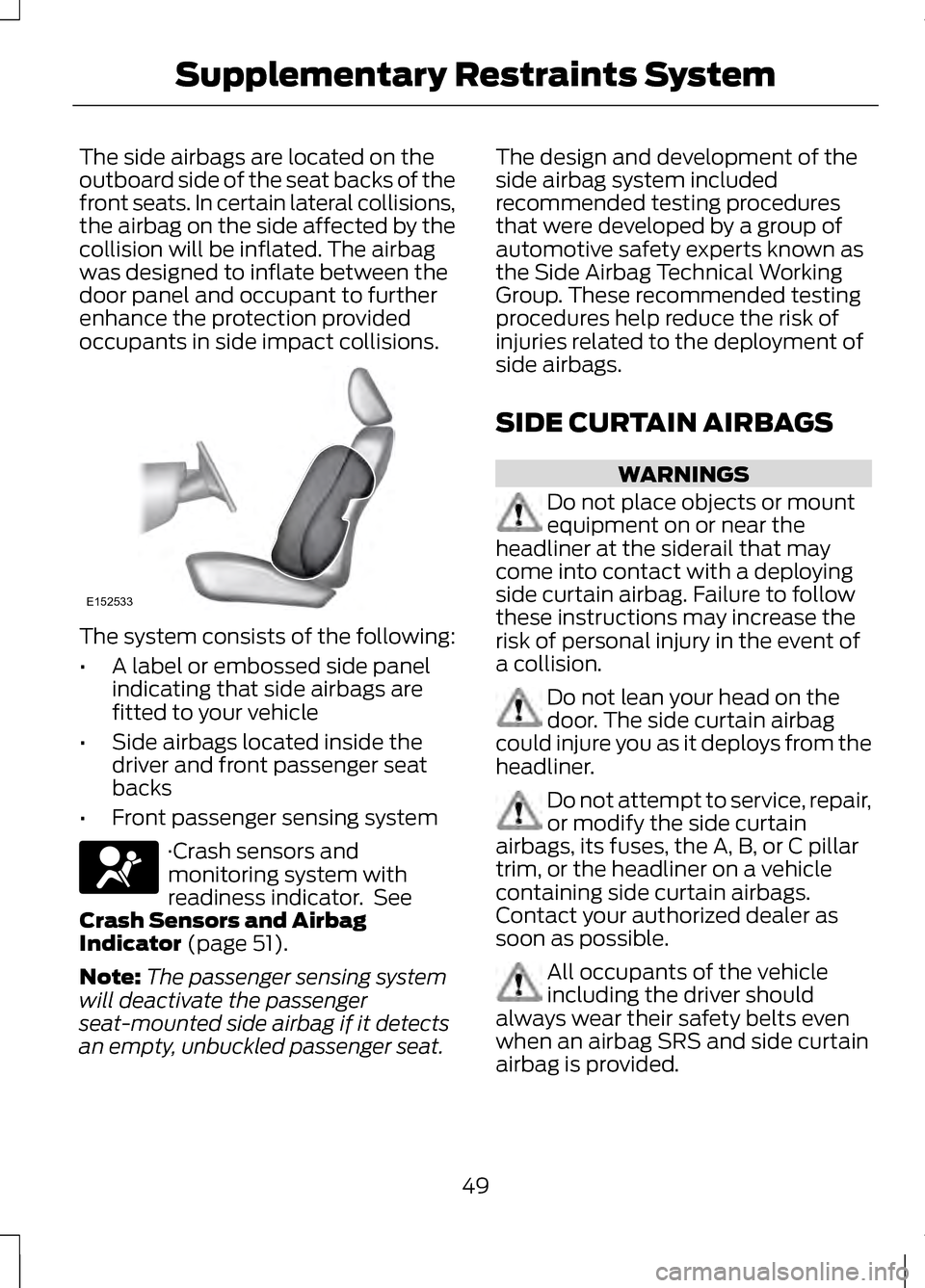
The side airbags are located on the
outboard side of the seat backs of the
front seats. In certain lateral collisions,
the airbag on the side affected by the
collision will be inflated. The airbag
was designed to inflate between the
door panel and occupant to further
enhance the protection provided
occupants in side impact collisions.
The system consists of the following:
•
A label or embossed side panel
indicating that side airbags are
fitted to your vehicle
• Side airbags located inside the
driver and front passenger seat
backs
• Front passenger sensing system ·Crash sensors and
monitoring system with
readiness indicator. See
Crash Sensors and Airbag
Indicator (page 51).
Note: The passenger sensing system
will deactivate the passenger
seat-mounted side airbag if it detects
an empty, unbuckled passenger seat. The design and development of the
side airbag system included
recommended testing procedures
that were developed by a group of
automotive safety experts known as
the Side Airbag Technical Working
Group. These recommended testing
procedures help reduce the risk of
injuries related to the deployment of
side airbags.
SIDE CURTAIN AIRBAGS
WARNINGS
Do not place objects or mount
equipment on or near the
headliner at the siderail that may
come into contact with a deploying
side curtain airbag. Failure to follow
these instructions may increase the
risk of personal injury in the event of
a collision. Do not lean your head on the
door. The side curtain airbag
could injure you as it deploys from the
headliner. Do not attempt to service, repair,
or modify the side curtain
airbags, its fuses, the A, B, or C pillar
trim, or the headliner on a vehicle
containing side curtain airbags.
Contact your authorized dealer as
soon as possible. All occupants of the vehicle
including the driver should
always wear their safety belts even
when an airbag SRS and side curtain
airbag is provided.
49
Supplementary Restraints SystemE152533
Page 53 of 474
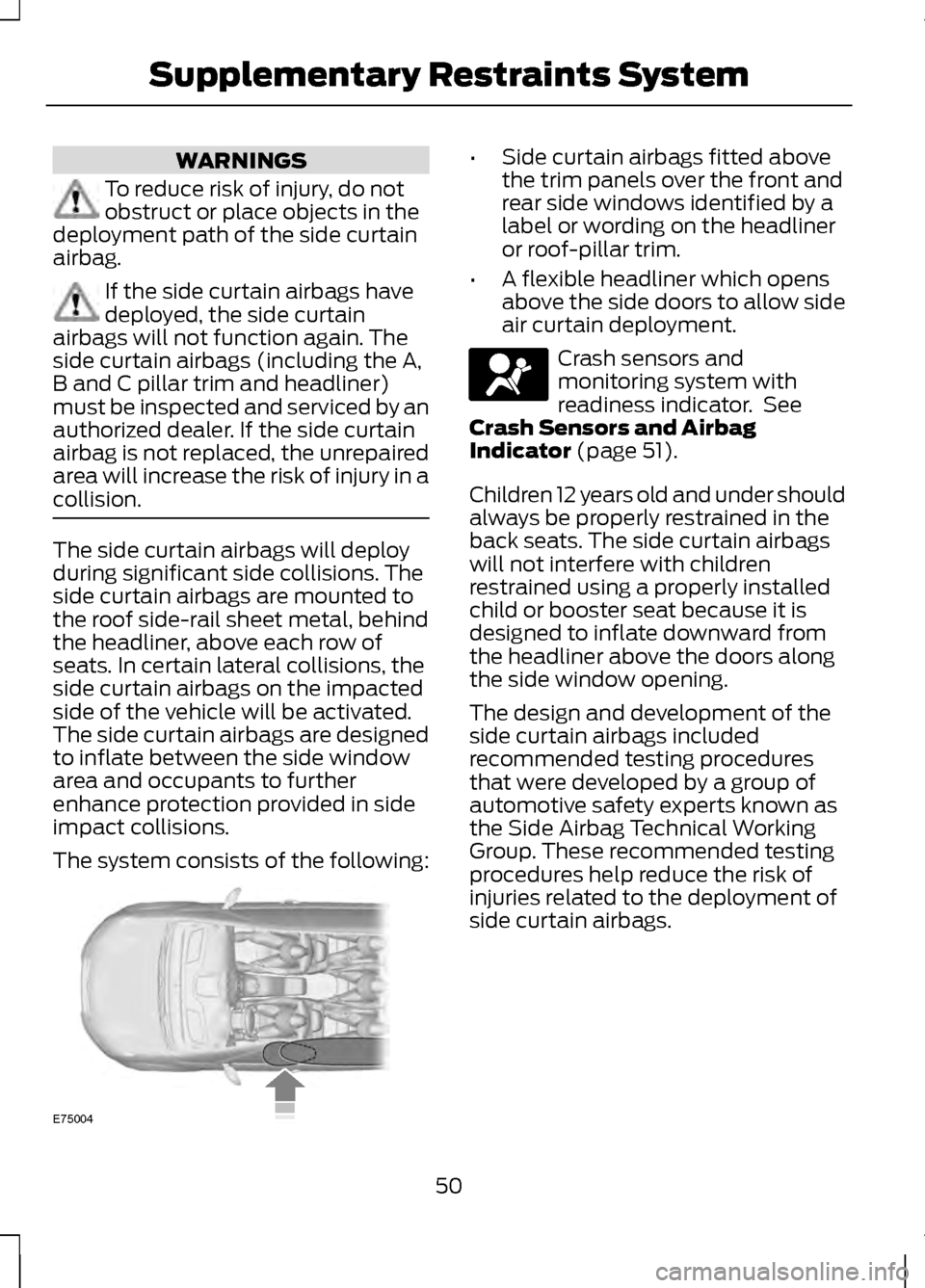
WARNINGS
To reduce risk of injury, do not
obstruct or place objects in the
deployment path of the side curtain
airbag. If the side curtain airbags have
deployed, the side curtain
airbags will not function again. The
side curtain airbags (including the A,
B and C pillar trim and headliner)
must be inspected and serviced by an
authorized dealer. If the side curtain
airbag is not replaced, the unrepaired
area will increase the risk of injury in a
collision. The side curtain airbags will deploy
during significant side collisions. The
side curtain airbags are mounted to
the roof side-rail sheet metal, behind
the headliner, above each row of
seats. In certain lateral collisions, the
side curtain airbags on the impacted
side of the vehicle will be activated.
The side curtain airbags are designed
to inflate between the side window
area and occupants to further
enhance protection provided in side
impact collisions.
The system consists of the following: •
Side curtain airbags fitted above
the trim panels over the front and
rear side windows identified by a
label or wording on the headliner
or roof-pillar trim.
• A flexible headliner which opens
above the side doors to allow side
air curtain deployment. Crash sensors and
monitoring system with
readiness indicator. See
Crash Sensors and Airbag
Indicator (page 51).
Children 12 years old and under should
always be properly restrained in the
back seats. The side curtain airbags
will not interfere with children
restrained using a properly installed
child or booster seat because it is
designed to inflate downward from
the headliner above the doors along
the side window opening.
The design and development of the
side curtain airbags included
recommended testing procedures
that were developed by a group of
automotive safety experts known as
the Side Airbag Technical Working
Group. These recommended testing
procedures help reduce the risk of
injuries related to the deployment of
side curtain airbags.
50
Supplementary Restraints SystemE75004
Page 54 of 474
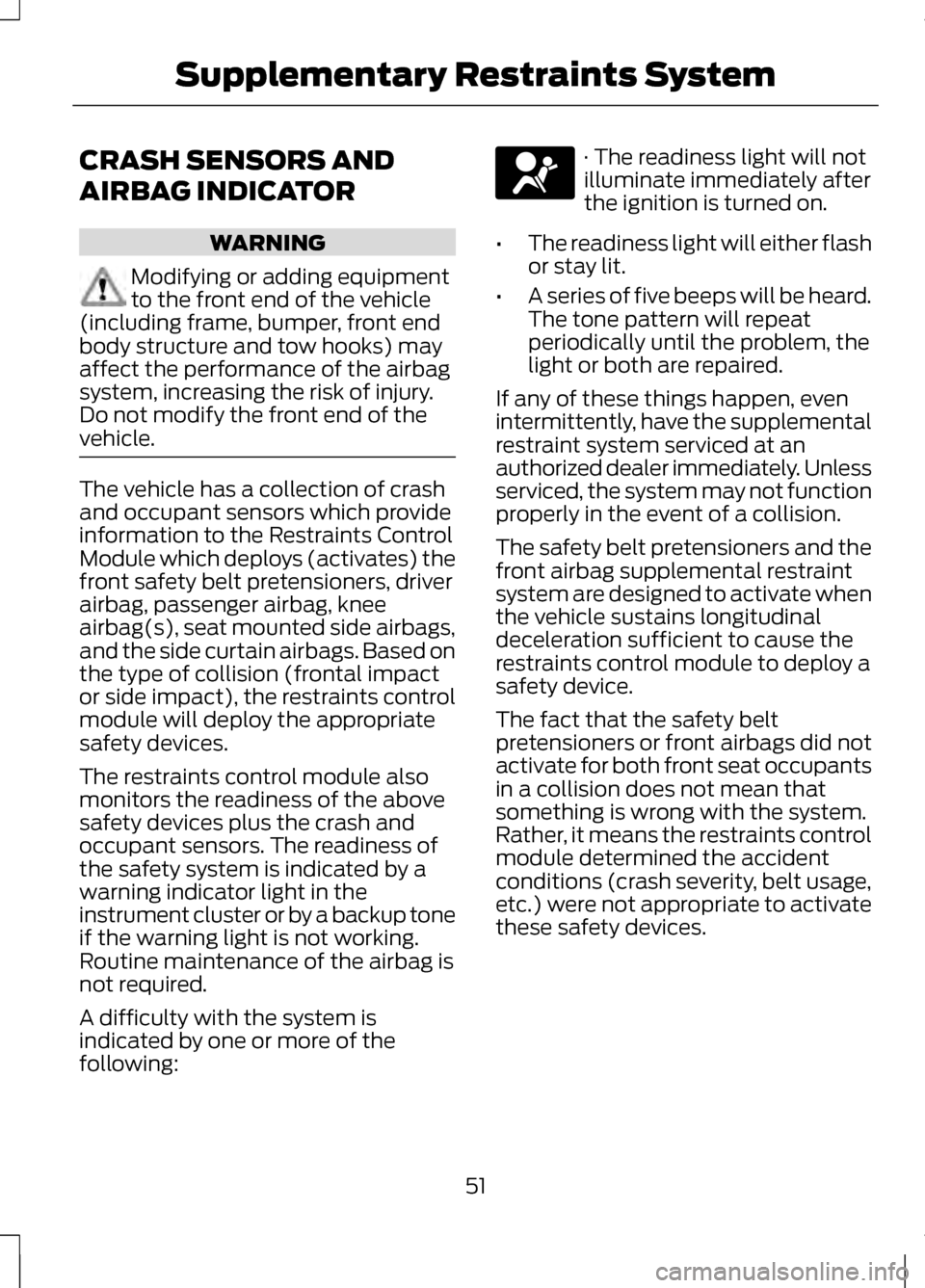
CRASH SENSORS AND
AIRBAG INDICATOR
WARNING
Modifying or adding equipment
to the front end of the vehicle
(including frame, bumper, front end
body structure and tow hooks) may
affect the performance of the airbag
system, increasing the risk of injury.
Do not modify the front end of the
vehicle. The vehicle has a collection of crash
and occupant sensors which provide
information to the Restraints Control
Module which deploys (activates) the
front safety belt pretensioners, driver
airbag, passenger airbag, knee
airbag(s), seat mounted side airbags,
and the side curtain airbags. Based on
the type of collision (frontal impact
or side impact), the restraints control
module will deploy the appropriate
safety devices.
The restraints control module also
monitors the readiness of the above
safety devices plus the crash and
occupant sensors. The readiness of
the safety system is indicated by a
warning indicator light in the
instrument cluster or by a backup tone
if the warning light is not working.
Routine maintenance of the airbag is
not required.
A difficulty with the system is
indicated by one or more of the
following: · The readiness light will not
illuminate immediately after
the ignition is turned on.
• The readiness light will either flash
or stay lit.
• A series of five beeps will be heard.
The tone pattern will repeat
periodically until the problem, the
light or both are repaired.
If any of these things happen, even
intermittently, have the supplemental
restraint system serviced at an
authorized dealer immediately. Unless
serviced, the system may not function
properly in the event of a collision.
The safety belt pretensioners and the
front airbag supplemental restraint
system are designed to activate when
the vehicle sustains longitudinal
deceleration sufficient to cause the
restraints control module to deploy a
safety device.
The fact that the safety belt
pretensioners or front airbags did not
activate for both front seat occupants
in a collision does not mean that
something is wrong with the system.
Rather, it means the restraints control
module determined the accident
conditions (crash severity, belt usage,
etc.) were not appropriate to activate
these safety devices.
51
Supplementary Restraints System
Page 55 of 474

•
Front airbags are designed to
activate only in frontal and
near-frontal collisions (not
rollovers, side impacts or rear
impacts) unless the collision
causes sufficient longitudinal
deceleration.
• The safety belt pretensioners are
designed to activate in frontal and
near-frontal collisions, and may
also activate when a side curtain
deploys.
• A knee airbag deploys from under
the instrument panel when the
front airbag activates in a collision.
• Side airbags and side curtain
airbags are designed to inflate in
side-impact collisions, not
rollovers, rear impacts, frontal or
near-frontal collisions, unless the
collision causes sufficient lateral
deceleration.
AIRBAG DISPOSAL
Contact your authorized dealer as
soon as possible. Airbags MUST BE
disposed of by qualified personnel.
52
Supplementary Restraints System
Page 56 of 474
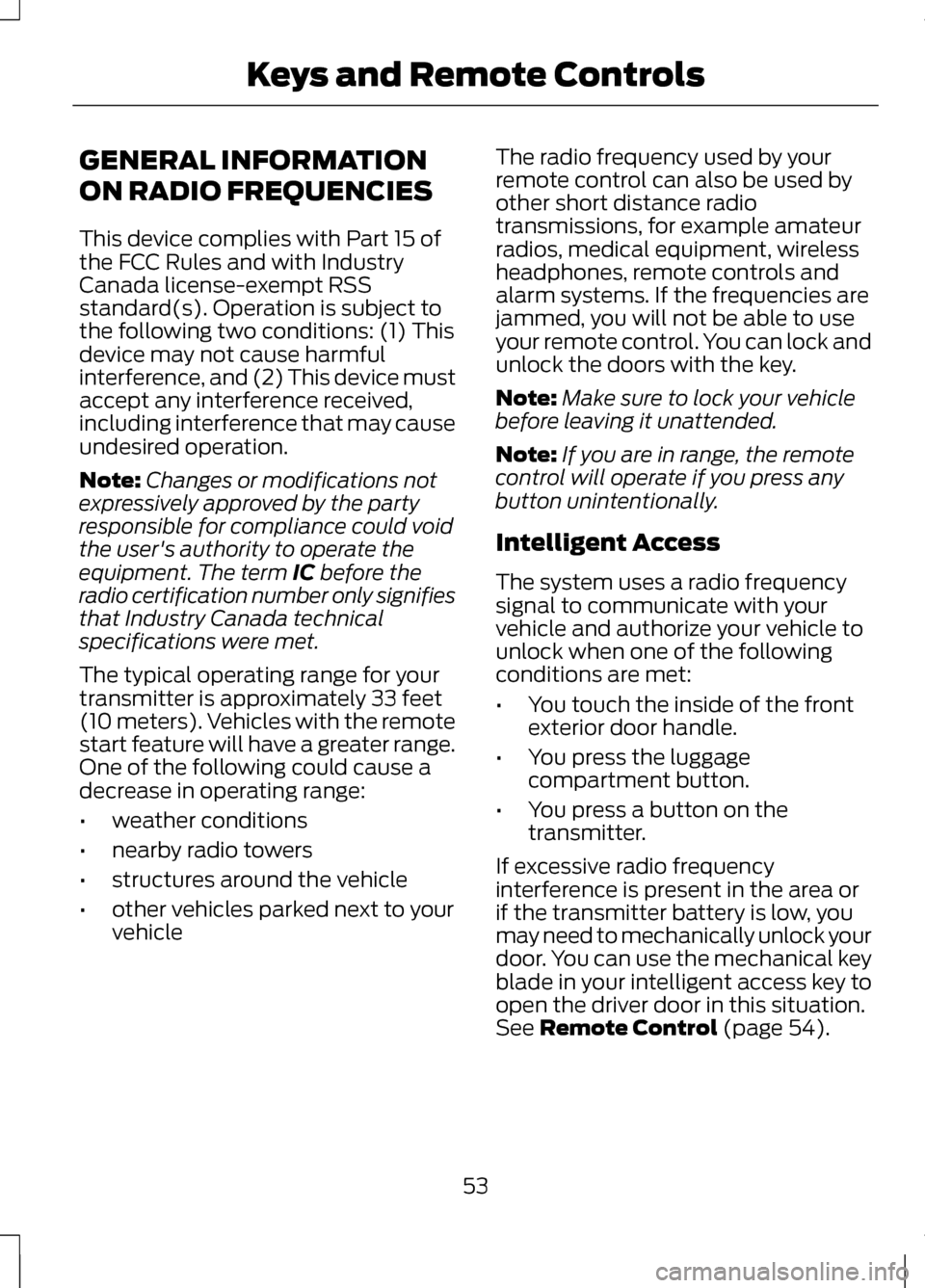
GENERAL INFORMATION
ON RADIO FREQUENCIES
This device complies with Part 15 of
the FCC Rules and with Industry
Canada license-exempt RSS
standard(s). Operation is subject to
the following two conditions: (1) This
device may not cause harmful
interference, and (2) This device must
accept any interference received,
including interference that may cause
undesired operation.
Note:
Changes or modifications not
expressively approved by the party
responsible for compliance could void
the user's authority to operate the
equipment. The term IC before the
radio certification number only signifies
that Industry Canada technical
specifications were met.
The typical operating range for your
transmitter is approximately 33 feet
(10 meters). Vehicles with the remote
start feature will have a greater range.
One of the following could cause a
decrease in operating range:
• weather conditions
• nearby radio towers
• structures around the vehicle
• other vehicles parked next to your
vehicle The radio frequency used by your
remote control can also be used by
other short distance radio
transmissions, for example amateur
radios, medical equipment, wireless
headphones, remote controls and
alarm systems. If the frequencies are
jammed, you will not be able to use
your remote control. You can lock and
unlock the doors with the key.
Note:
Make sure to lock your vehicle
before leaving it unattended.
Note: If you are in range, the remote
control will operate if you press any
button unintentionally.
Intelligent Access
The system uses a radio frequency
signal to communicate with your
vehicle and authorize your vehicle to
unlock when one of the following
conditions are met:
• You touch the inside of the front
exterior door handle.
• You press the luggage
compartment button.
• You press a button on the
transmitter.
If excessive radio frequency
interference is present in the area or
if the transmitter battery is low, you
may need to mechanically unlock your
door. You can use the mechanical key
blade in your intelligent access key to
open the driver door in this situation.
See
Remote Control (page 54).
53
Keys and Remote Controls
Page 57 of 474
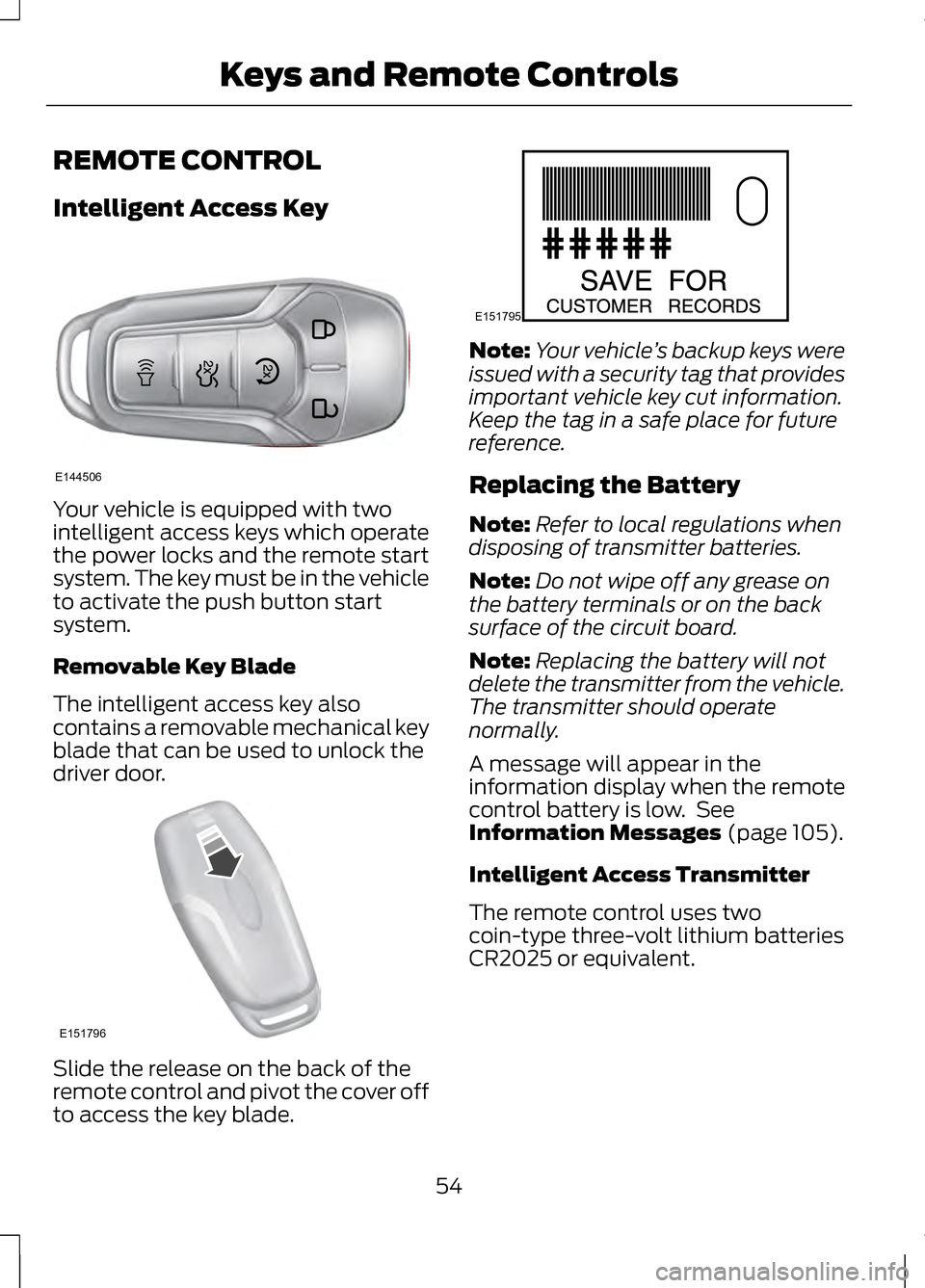
REMOTE CONTROL
Intelligent Access Key
Your vehicle is equipped with two
intelligent access keys which operate
the power locks and the remote start
system. The key must be in the vehicle
to activate the push button start
system.
Removable Key Blade
The intelligent access key also
contains a removable mechanical key
blade that can be used to unlock the
driver door.
Slide the release on the back of the
remote control and pivot the cover off
to access the key blade. Note:
Your vehicle ’s backup keys were
issued with a security tag that provides
important vehicle key cut information.
Keep the tag in a safe place for future
reference.
Replacing the Battery
Note: Refer to local regulations when
disposing of transmitter batteries.
Note: Do not wipe off any grease on
the battery terminals or on the back
surface of the circuit board.
Note: Replacing the battery will not
delete the transmitter from the vehicle.
The transmitter should operate
normally.
A message will appear in the
information display when the remote
control battery is low. See
Information Messages (page 105).
Intelligent Access Transmitter
The remote control uses two
coin-type three-volt lithium batteries
CR2025 or equivalent.
54
Keys and Remote ControlsE144506 E151796 E151795
Page 58 of 474
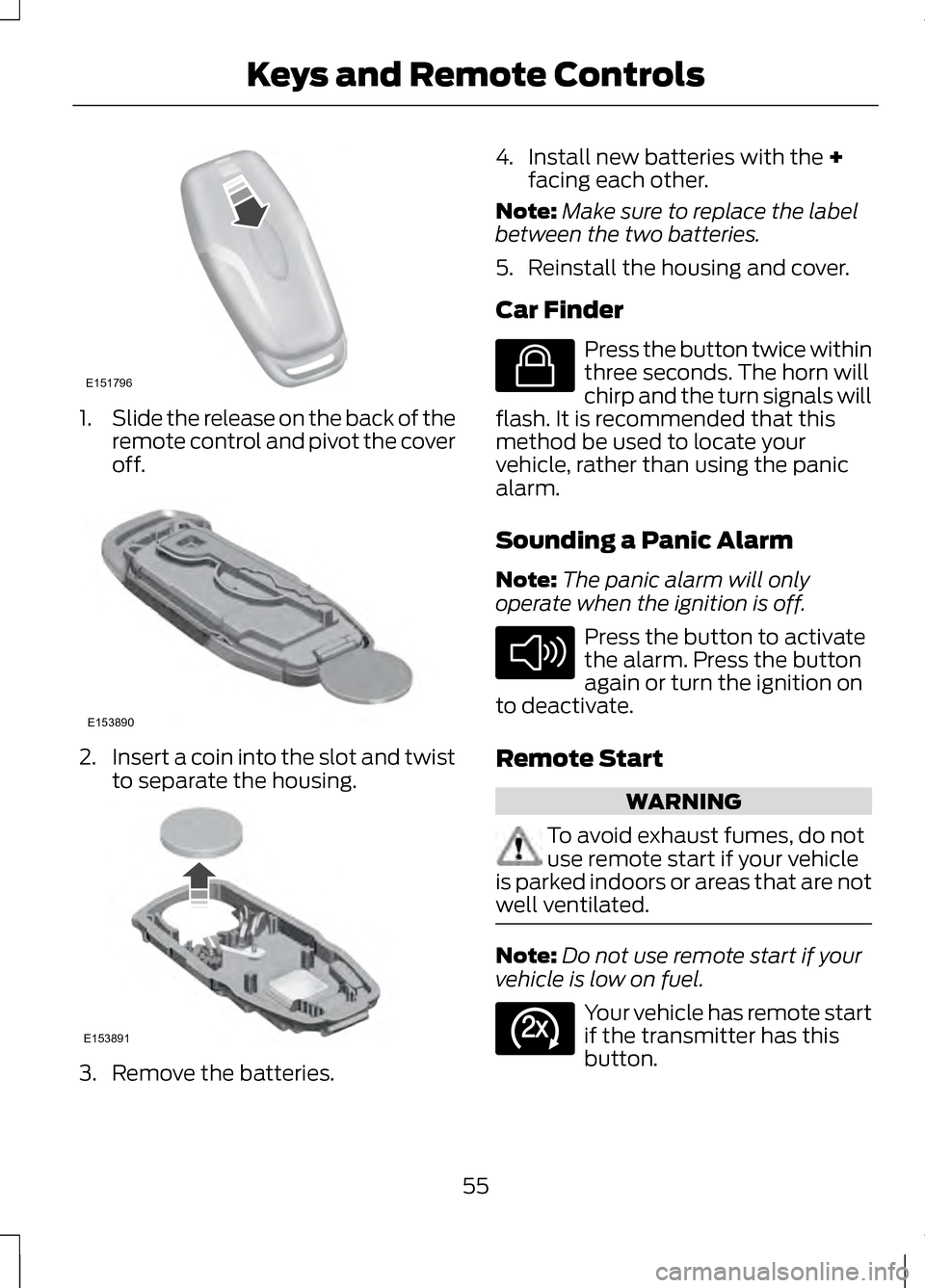
1.
Slide the release on the back of the
remote control and pivot the cover
off. 2.
Insert a coin into the slot and twist
to separate the housing. 3. Remove the batteries. 4. Install new batteries with the +
facing each other.
Note: Make sure to replace the label
between the two batteries.
5. Reinstall the housing and cover.
Car Finder Press the button twice within
three seconds. The horn will
chirp and the turn signals will
flash. It is recommended that this
method be used to locate your
vehicle, rather than using the panic
alarm.
Sounding a Panic Alarm
Note: The panic alarm will only
operate when the ignition is off. Press the button to activate
the alarm. Press the button
again or turn the ignition on
to deactivate.
Remote Start WARNING
To avoid exhaust fumes, do not
use remote start if your vehicle
is parked indoors or areas that are not
well ventilated. Note:
Do not use remote start if your
vehicle is low on fuel. Your vehicle has remote start
if the transmitter has this
button.
55
Keys and Remote ControlsE151796 E153890 E153891 E138623 E138624 E138625
Page 59 of 474
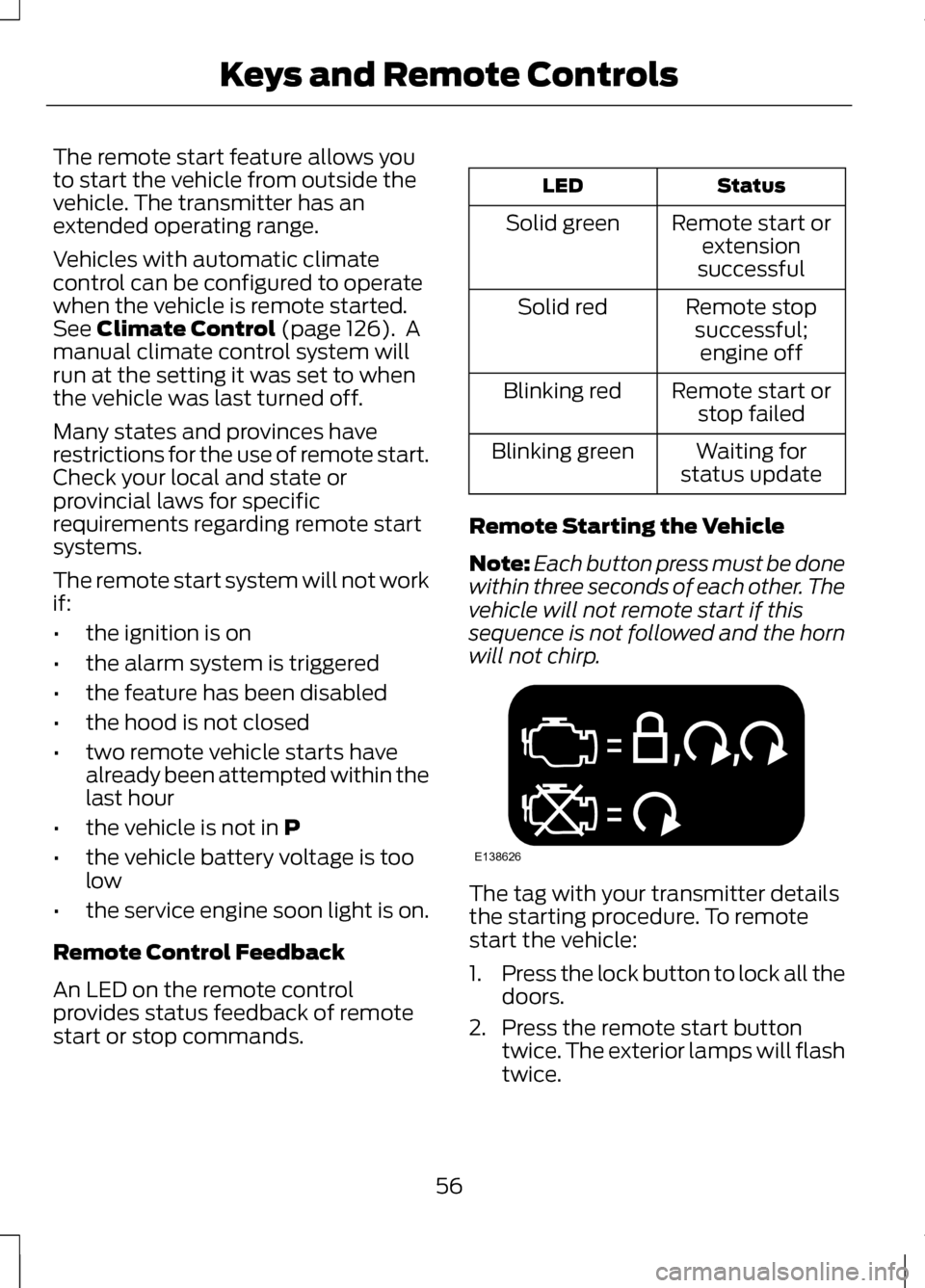
The remote start feature allows you
to start the vehicle from outside the
vehicle. The transmitter has an
extended operating range.
Vehicles with automatic climate
control can be configured to operate
when the vehicle is remote started.
See Climate Control (page 126). A
manual climate control system will
run at the setting it was set to when
the vehicle was last turned off.
Many states and provinces have
restrictions for the use of remote start.
Check your local and state or
provincial laws for specific
requirements regarding remote start
systems.
The remote start system will not work
if:
• the ignition is on
• the alarm system is triggered
• the feature has been disabled
• the hood is not closed
• two remote vehicle starts have
already been attempted within the
last hour
• the vehicle is not in
P
• the vehicle battery voltage is too
low
• the service engine soon light is on.
Remote Control Feedback
An LED on the remote control
provides status feedback of remote
start or stop commands. Status
LED
Remote start orextension
successful
Solid green
Remote stopsuccessful;engine off
Solid red
Remote start orstop failed
Blinking red
Waiting for
status update
Blinking green
Remote Starting the Vehicle
Note: Each button press must be done
within three seconds of each other. The
vehicle will not remote start if this
sequence is not followed and the horn
will not chirp. The tag with your transmitter details
the starting procedure. To remote
start the vehicle:
1.
Press the lock button to lock all the
doors.
2. Press the remote start button twice. The exterior lamps will flash
twice.
56
Keys and Remote ControlsE138626
Page 60 of 474
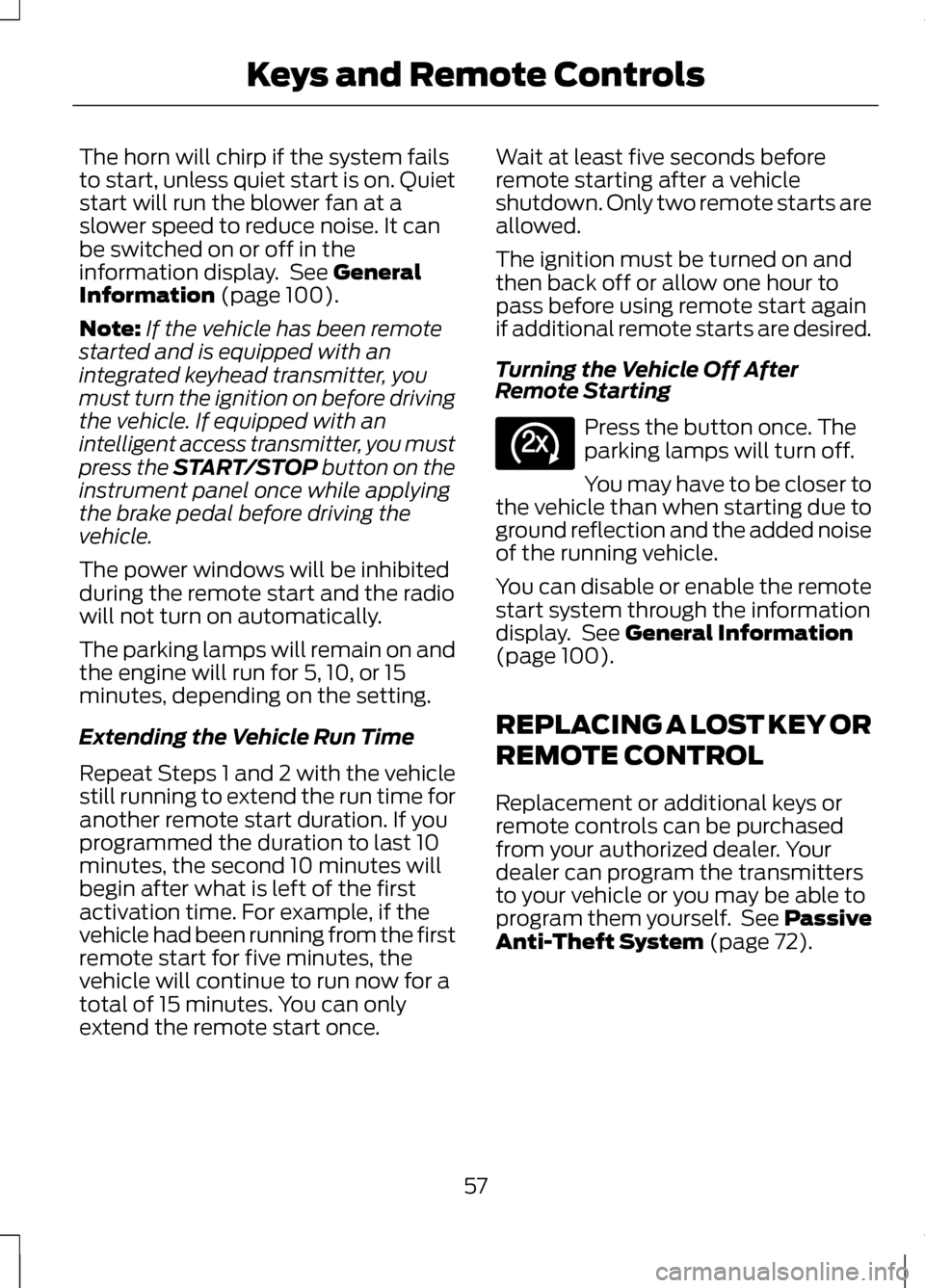
The horn will chirp if the system fails
to start, unless quiet start is on. Quiet
start will run the blower fan at a
slower speed to reduce noise. It can
be switched on or off in the
information display. See General
Information (page 100).
Note: If the vehicle has been remote
started and is equipped with an
integrated keyhead transmitter, you
must turn the ignition on before driving
the vehicle. If equipped with an
intelligent access transmitter, you must
press the
START/STOP button on the
instrument panel once while applying
the brake pedal before driving the
vehicle.
The power windows will be inhibited
during the remote start and the radio
will not turn on automatically.
The parking lamps will remain on and
the engine will run for 5, 10, or 15
minutes, depending on the setting.
Extending the Vehicle Run Time
Repeat Steps 1 and 2 with the vehicle
still running to extend the run time for
another remote start duration. If you
programmed the duration to last 10
minutes, the second 10 minutes will
begin after what is left of the first
activation time. For example, if the
vehicle had been running from the first
remote start for five minutes, the
vehicle will continue to run now for a
total of 15 minutes. You can only
extend the remote start once. Wait at least five seconds before
remote starting after a vehicle
shutdown. Only two remote starts are
allowed.
The ignition must be turned on and
then back off or allow one hour to
pass before using remote start again
if additional remote starts are desired.
Turning the Vehicle Off After
Remote Starting
Press the button once. The
parking lamps will turn off.
You may have to be closer to
the vehicle than when starting due to
ground reflection and the added noise
of the running vehicle.
You can disable or enable the remote
start system through the information
display. See
General Information
(page 100).
REPLACING A LOST KEY OR
REMOTE CONTROL
Replacement or additional keys or
remote controls can be purchased
from your authorized dealer. Your
dealer can program the transmitters
to your vehicle or you may be able to
program them yourself. See Passive
Anti-Theft System
(page 72).
57
Keys and Remote ControlsE138625